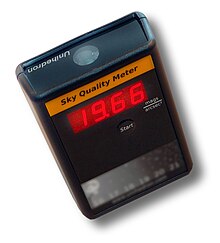Sky quality meter

A sky quality meter (SQM) is an instrument used to measure the luminance of the night sky. It is used, typically by amateur astronomers, to quantify the skyglow aspect of light pollution and uses units of "magnitudes per square arcsecond" favored by astronomers. SQM measurements can be submitted to a database on the manufacturer's website and to the citizen science project GLOBE at Night.
There are several models of SQM made, offering different fields of view (i.e. measuring different angular areas on the sky), and various automatic measurement and data logging or data communication capabilities. The current versions has only one band of observation, that can produce misinterpretations if the light pollution changes from sodium-vapor lamp to LED.[1]
The SQM is produced by the Canadian company Unihedron in Grimsby, Ontario.
Scale
The values reported by the SQM are in units of magnitudes per square arcsecond (mag arcsec-2). As astronomical magnitudes are a negative logarithmic scale, smaller values indicate a brighter sky and a difference of 5 mag arcsec-2 corresponds to a difference in luminance of 100 times. Typical values will range between around 16 for bright urban skies to 22 for the darkest skies on Earth[1].
References
- ^ a b Sánchez de Miguel, Alejandro; Aubé, Martin; Zamorano, Jaime; Kocifaj, Miroslav; Roby, Johanne; Tapia, Carlos (3 March 2017). "Sky Quality Meter measurements in a colour-changing world". Monthly Notices of the Royal Astronomical Society. 467 (3): 2966. arXiv:1701.05019. Bibcode:2017MNRAS.467.2966S. doi:10.1093/mnras/stx145. Retrieved 18 April 2017.
External links
- Product page on Unihedron webpage
- GLOBE at Night project
- Network of SQM measurements
- Scale and Instructions on Unihedron webpage
- v
- t
- e











